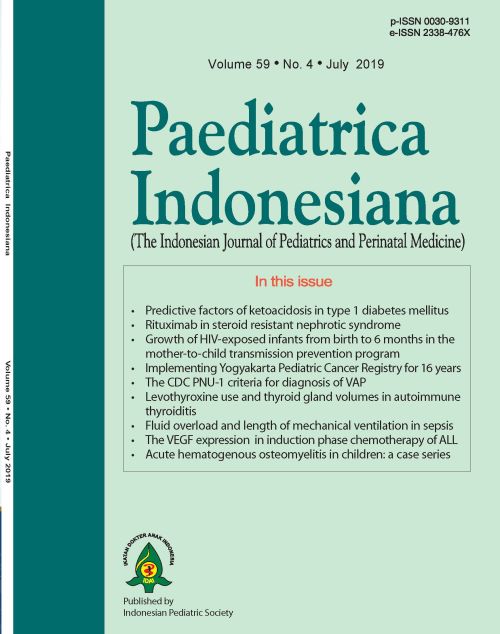Fluid overload and length of mechanical ventilation in pediatric sepsis
DOI:
https://doi.org/10.14238/pi59.4.2019.211-6Keywords:
fluid overload; sepsis; length of mechanical ventilationAbstract
Background Children with sepsis often experience hemodynamic failure and would benefit from fluid resuscitation. On the other hand, critically ill children with sepsis have a higher risk of fluid accumulation due to increased capillary hydrostatic pressure and permeability. Therefore, fluid overload may result in higher morbidity and mortality during pediatric intensive care unit (PICU) hospitalization.
Objective To evaluate the correlation between fluid overload and the length of mechanical ventilation in children with sepsis admitted to the PICU.
Methods Our retrospective cohort study included children aged 1 month-18 years with sepsis who were admitted to the PICU between January 2013 and June 2018 and mechanically-ventilated. Secondary data was extracted from subjects’ medical records. Data analyses used were independent T-test and survival analysis.
Results Of 444 children admitted to the PICU, 166 initially met the inclusion criteria. Of those, 17 children were excluded due to congenital heart disease. Subjects' median age was 19 months and median PELOD-2 score was 8. Eighteen children (12.1%) had positive fluid balance in the first 48 hours. Median mechanical ventilation duration was 5 days. Fluid overload was significantly correlated with length of mechanical ventilation (P=0.01) and PICU mortality (RR=2.06; 95%CI 2.56 to 166; P=0.001). Neither length of PICU stay nor extubation failure were significantly correlated to fluid overload.
Conclusion Fluid overload was significantly correlated with length of mechanical ventilation and may be a predictor of mortality in children with sepsis in the PICU.
References
2. Weiss SL, Fitzgerald JC, Pappachan J, Wheeler D, Jaramillo-Bustamante JC, Salloo A, et al. Global epidemiology of pediatric severe sepsis: the sepsis prevalence, outcomes, and therapies study. Am J Respir Crit Care Med. 2015;191:1147–57.
3. Kawasaki T. Update on pediatric sepsis: A review. J Intensive Care. 2017;5:1–12.
4. El-Wiher N, Cornell TT, Kissoon N, Shanley TP. Management and Treatment Guidelines for Sepsis in Pediatric Patients. Open Inflamm J. 2011;4(Suppl 1-M11):101–9.
5. Chelazzi C, Villa G, Mancinelli P, De Gaudio AR, Adembri C. Glycocalyx and sepsis-induced alterations in vascular permeability. Crit Care. 2015;19:1–7.
6. Henrich M, Gruss M, Weigand MA. Sepsis-Induced Degradation of Endothelial Glycocalix. Sci World J. 2010;10:917–23.
7. Vidal S, Perez A, Eulmesekian P. Fluid balance and length of mechanical ventilation in children admitted to a single Pediatric Intensive Care Unit. Arch argent Pediatr. 2016;114:313–8.
8. Arikan AA, Zappitelli M, Goldstein SL, Naipaul A, Jefferson LS, Loftis LL. Fluid overload is associated with impaired oxygenation and morbidity in critically ill children. Pediatr Crit Care Med. 2012;13:253–8.
9. Acheampong A, Vincent J. A positive fluid balance is an independent prognostic factor in patients with sepsis. Crit Care. 2015;19:1–7.
10. Ikatan Dokter Anak Indonesia. Diagnosis dan tatalaksana sepsis pada anak. Latief A, Chairulfatah A, Alam A, Pudjiadi AH, Malisie R, Hadinegoro SR, editors. Jakarta: Badan Penerbit IDAI; 2016. p.1-48.
11. Chen J, Li X, Bai Z, Fang F, Hua J, Li Y, et al. Association of fluid accumulation with clinical outcomes in critically ill children with severe sepsis. PLoS One. 2016;11:1–17.
12. Koonrangsesomboon W, Khwannimit B. Impact of positive fluid balance on mortality and length of stay in septic shock patients. Indian J Crit Care Med. 2015;19:708–13.
13. Nupen TL, Argent AC, Morrow BM. Characteristics and outcome of long-stay patients in a paediatric intensive care unit in Cape Town, South Africa. South African Med J. 2017;107:70–5.
Downloads
Published
How to Cite
Issue
Section
License
Authors who publish with this journal agree to the following terms:
Authors retain copyright and grant the journal right of first publication with the work simultaneously licensed under a Creative Commons Attribution License that allows others to share the work with an acknowledgement of the work's authorship and initial publication in this journal.
Authors are able to enter into separate, additional contractual arrangements for the non-exclusive distribution of the journal's published version of the work (e.g., post it to an institutional repository or publish it in a book), with an acknowledgement of its initial publication in this journal.
Accepted 2019-07-18
Published 2019-07-18


















